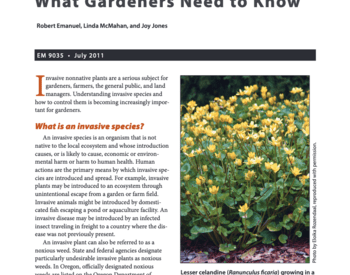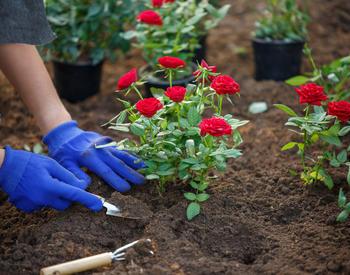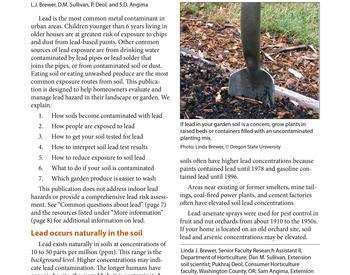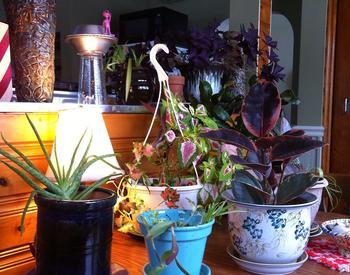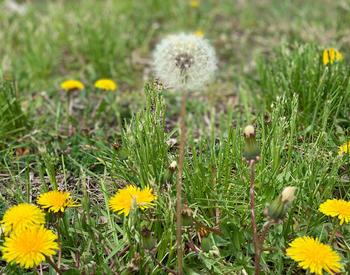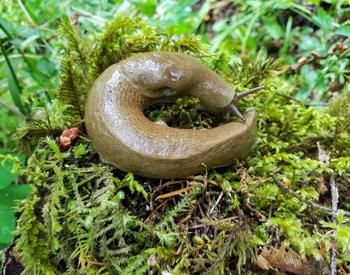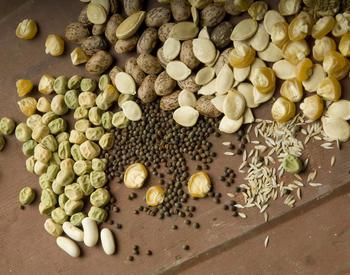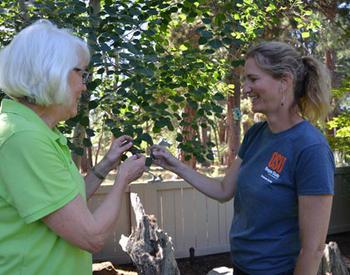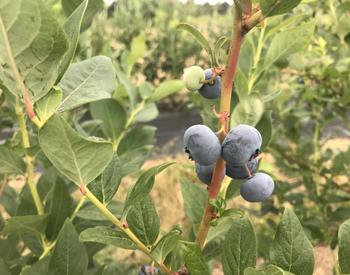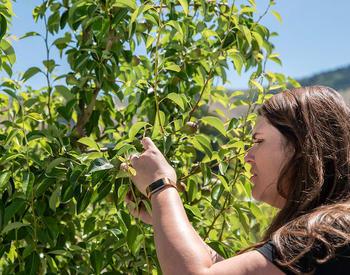External plant structures such as leaves, stems, roots, flowers, fruits and seeds are known as plant organs. Each organ is an organized group of tissues that works together to perform a specific function. These structures can be divided into two groups: sexual reproductive and vegetative. Sexual reproductive parts produce seed; they include flower buds, flowers, fruit and seeds.
Flowers
Sexual reproduction is the sole function of flowers, often the showiest part of a plant. Flowers' beauty and fragrance evolved not to please humans but to attract pollinators (insects or birds), which are central to the reproductive process.
The system of plant nomenclature we use today was developed by Carl von Linné (Linnaeus) and is based on flowers, reproductive parts of plants or both. One reason his system is successful is that flowers are the plant part least influenced by environmental changes. Thus, a knowledge of flowers and their parts is essential for anyone interested in plant identification.
Structure
As a plant's reproductive part, a flower contains a stamen (male flower part) or pistil (female flower part), or both, plus accessory parts such as sepals, petals, and nectar glands (Figure 19).
The stamen is the male reproductive organ. It consists of a pollen sac (anther) and a long supporting filament. This filament holds the anther in position, making the pollen available for dispersal by wind, insects, or birds.
The pistil is a plant's female part. It generally is shaped like a bowling pin and is located in the flower's center. It consists of a stigma, style and ovary. The stigma is located at the top and is connected by the style to the ovary. The ovary contains eggs, which reside in ovules. If an egg is fertilized, the ovule develops into a seed.
Sepals are small, green, leaflike structures located at the base of a flower. They protect the flower bud. Collectively, the sepals are called a calyx.
Petals generally are the highly colored portions of a flower. Like nectar glands, petals may contain perfume. Collectively, the petals are called a corolla. The number of petals on a flower often is used to help identify plant families and genera. Flowers of dicots typically have four or five sepals, petals or multiples thereof. In monocots, these floral parts typically come in threes or multiples of three.
Types of flowers
If a flower has a stamen, pistil, petals, and sepals, it is called a complete flower (Figure 19). Roses are an example. If one of these parts is missing, the flower is called incomplete.
The stamen and pistil are the essential parts of a flower and are involved in seed production. If a flower contains both functional stamens and pistils, it is called a perfect flower, even if it does not contain petals and sepals. If either stamens or pistils are lacking, the flower is called imperfect. Pistillate (female) flowers possess a functional pistil or pistils but lack stamens (Figure 20). Staminate (male) flowers contain stamens, but no pistils.
Plants with imperfect flowers are further classified as monoecious or dioecious.
Monoecious plants have separate male and female flowers on the same plant (e.g., corn and pecan). Some monoecious plants bear only male flowers at the beginning of the growing season, but later develop both sexes (e.g., cucumbers and squash).
Dioecious species have separate male and female plants. Examples include holly, ginkgo and pistachio. In order to set fruit, male and female plants must be planted close enough together for pollination to occur. In some instances (e.g., holly), the fruit is desirable. In the case of ginkgo, however, the fruit generally is not desirable due to its putrid smell when ripe. Kiwis are complicated because they may have one plant with bisexual flowers and another plant with only male flowers. The plant world doesn't always have absolutes!
Types of inflorescences
Some plants bear only one flower per stem, which is called a solitary flower. Other plants produce an inflorescence—a cluster of flowers. Each flower in an inflorescence is called a floret.
Most inflorescences belong to one of two groups: racemes and cymes. In the racemose group, the florets start blooming from the bottom of the stem and progress toward the top. In a cyme, the top floret opens first and blooms progress downward along the peduncle. Detailed discussions of flower types are found in many botany textbooks.
How seeds form
Pollination is the transfer of pollen from an anther to a stigma, either by wind or by pollinators. Species pollinated by insects, animals or birds often have brightly colored or patterned flowers that contain fragrance or nectar. While searching for nectar, pollinators transfer pollen from flower to flower, either on the same plant or on different plants. Plants evolved this ingenious mechanism in order to ensure their species' survival. Wind-pollinated flowers often lack showy floral parts and nectar because they don't need to attract pollinators.
A chemical in the stigma stimulates pollen to grow a long tube down the style to the ovules inside the ovary. When pollen reaches the ovules, it releases sperm, and fertilization typically occurs. Fertilization is the union of a male sperm nucleus from a pollen grain with a female egg. If fertilization is successful, the ovule develops into a seed. It is important to remember that pollination is no guarantee that fertilization will occur.
Cross-fertilization combines genetic material from two parent plants. The resulting seed has a broader genetic base, which may enable the population to survive under a wider range of environmental conditions. Cross-pollinated plants usually are more successful than self-pollinated plants. Consequently, more plants reproduce by cross-pollination than by self-pollination.
Fruit
Structure
Fruit consists of fertilized, mature ovules (seeds) plus the ovary wall, which may be fleshy, as in an apple, or dry and hard, as in an acorn. In some fruits, the seeds are enclosed within the ovary (e.g., apples, peaches, oranges, squash and cucumbers). In others, seeds are situated on the outside of fruit tissue (e.g., corn and strawberries).
The only part of the fruit that contains genes from both the male and female flowers are the seeds. The rest of the fruit arises from the maternal plant and is genetically identical to it.
Types of fruit
Fruits are classified as simple, aggregate or multiple (Figure 21). Simple fruits develop from a single ovary. They include fleshy fruits such as cherries and peaches (drupe), pears and apples (pome) and tomatoes (berries). Although generally referred to as a vegetable, tomatoes technically are a fruit because they develop from a flower. Squash, cucumbers, and eggplants also develop from a single ovary and are classified botanically as fruits.
Other types of simple fruit are dry. Their wall is either papery or leathery and hard, as opposed to the fleshy examples just mentioned. Examples are peanuts (legume), poppies (capsule), maples (samara) and walnuts (nut).
An aggregate fruit develops from a single flower with many ovaries, such as with strawberries, raspberries and blackberries. The flower is a simple flower with one corolla, one calyx and one stem, but it has many pistils or ovaries. Each ovary is fertilized separately. If some ovules are not pollinated successfully, the fruit will be misshapen.
Multiple fruits are derived from a tight cluster of separate, independent flowers borne on a single structure. Each flower has its own calyx and corolla. Pineapples and figs are examples.
Seeds
A seed contains all of the genetic information needed to develop into an entire plant. It is made up of three parts (Figure 22):
- The embryo is a miniature plant in an arrested state of development. It will begin to grow when conditions are favorable.
- The endosperm (and in some species the cotyledons) is a built-in food supply (although orchids are an exception), which can be made up of proteins, carbohydrates or fats.
- The seed coat, a hard outer covering, protects the seed from disease and insects. It also prevents water from entering the seed and initiating germination before the proper time.
Germination
Germination is when a seed embryo goes from a dormant state to an active, growing state (Figure 23). Before any visual signs of germination appear, the seed must absorb water through its seed coat. It also must have enough oxygen and a favorable temperature. Some species, such as celery, also require light. Others require darkness.
If these requirements are met, the radicle is the first part of the seedling to emerge from the seed. It develops into the primary root and grows downward in response to gravity. From this primary root, root hairs and lateral roots develop. Between the radicle and the first leaflike structure is the hypocotyl, which grows upward in response to light.
The seed leaves, or cotyledons, encase the embryo. They usually are shaped differently than the leaves the mature plant will produce. Monocots produce one cotyledon, while dicots produce two.
Because seeds are reproductive structures and thus important to a species' survival, plants have evolved many mechanisms to ensure their survival. One such mechanism is seed dormancy. Dormancy comes in two forms: seed coat dormancy and embryo dormancy.
In seed coat dormancy, a hard seed coat does not allow water to penetrate. Redbud, locust and many other ornamental trees and shrubs exhibit this type of dormancy.
A process called scarification is used to break or soften the seed coat. In nature, scarification is accomplished by means such as the heat of a forest fire, digestion of the seed by a bird or mammal, or partial breakdown of the seed coat by fungi or insects. It can be done mechanically by nicking the seed coat with a file, or chemically by softening the seed coat with sulfuric acid. In either instance, it is important to not damage the embryo.
Embryo dormancy is common in ornamental plants, including elm and witch hazel. These seeds must go through a chilling period before germinating. To break this type of dormancy, stratification is used. This process involves storing seeds in a moist medium (potting soil or paper towels) at temperatures between 32°F and 50°F. The length of time required varies by species.
Even when environmental requirements for seed germination are met and dormancy is broken, other factors also affect germination:
- The seed's age greatly affects its viability (ability to germinate). Older seed generally is less viable than young seed, and if it does germinate, the seedlings are less vigorous and grow more slowly.
- The seedbed must be properly prepared and made up of loose, fine-textured soil.
- Seeds must be planted at the proper depth. If they are too shallow, they may wash away with rain or watering; if too deep, they won't be able to push through the soil.
- Seeds must have a continual supply of moisture; however, if over-watered, they will rot.
Many weed seeds are able to germinate quickly and under less than optimal conditions. This is one reason they make such formidable opponents in the garden.


